Tea in Health and Disease
A special issue of Nutrients (ISSN 2072-6643).
Deadline for manuscript submissions: closed (1 November 2018) | Viewed by 143897
Special Issue Editor
Interests: molecular targeting; cancer-targeted therapy; drug discovery; drug repurpose; chemoprevention; and ubiquitin–proteasome system inhibitors
Special Issues, Collections and Topics in MDPI journals
Special Issue Information
Dear Colleagues,
Tea, made from the leaves of the Camellia senenisis plant, is the second most consumed beverage worldwide after water. Accumulating evidence from cellular, animal, epidemiological and clinical studies have linked tea consumption to various health benefits, such as chemoprevention of cancers, chronic inflammation, heart and liver diseases, diabetes, neurodegenerative diseases, etc. Although such health benefits have not been consistently observed in some intervention trials, positive results from clinical trials have provided direct evidence supporting the cancer-protective effect of green tea. In addition, numerous mechanisms of action have been suggested to contribute to tea’s disease-preventive effects. Furthermore, effects of the processing and storage of tea, as well as additives on tea’s properties have been investigated.
The objective of this proposed Special Issue, “Tea in Health and Disease”, is to publish selected review and research papers detailing the anti-cancer and anti-disease effects of tea, as well as the involved potential molecular targets, biological pathways and mechanisms of action. Articles reporting strategies on how to retain tea’s beneficial activities during its processing and storage will also be included. I encourage you to submit your manuscripts that fit these objectives and topics of this Special Issue. Thank you.
Dr. Q. Ping DouGuest Editor
Manuscript Submission Information
Manuscripts should be submitted online at www.mdpi.com by registering and logging in to this website. Once you are registered, click here to go to the submission form. Manuscripts can be submitted until the deadline. All submissions that pass pre-check are peer-reviewed. Accepted papers will be published continuously in the journal (as soon as accepted) and will be listed together on the special issue website. Research articles, review articles as well as short communications are invited. For planned papers, a title and short abstract (about 100 words) can be sent to the Editorial Office for announcement on this website.
Submitted manuscripts should not have been published previously, nor be under consideration for publication elsewhere (except conference proceedings papers). All manuscripts are thoroughly refereed through a single-blind peer-review process. A guide for authors and other relevant information for submission of manuscripts is available on the Instructions for Authors page. Nutrients is an international peer-reviewed open access semimonthly journal published by MDPI.
Please visit the Instructions for Authors page before submitting a manuscript. The Article Processing Charge (APC) for publication in this open access journal is 2900 CHF (Swiss Francs). Submitted papers should be well formatted and use good English. Authors may use MDPI's English editing service prior to publication or during author revisions.
Keywords
- Tea
- Cancer
- Diseases
- Antioxidants
- Chemoprevention
- Flavonoids
- Catechins
- Polyphenols
- Molecular targets
- Tea processing and storage







